Over the last couple of years, the Shekhawati Haveli has gained immense attention in the Rajasthan tourist circuit. Among travelers, the Shekhawati regions rank quite high among the places to visit in Rajasthan. Jaipur, Jodhpur, Udaipur, and Jaisalmer have been stalwarts of the tourism industry of Rajasthan. Places like Pushkar, Mount Abu, Ranakpur, and Ranthambore joined much later to complete the offering. Shekhawati region completes the offering. The Shekhawati region is one of the most popular short weekend trips from Jaipur. I never had the motivation to visit places like Mandawa, Nawalgarh, Ramgarh, and Churu. The reasons stemmed largely because it wasn’t something novel for me. I have undertaken innumerable trips to the ancestral town since childhood which falls on the fringes of Shekhawati yet not making it to the tourist circuit. Havelis never excited me as it does to most travelers because of lack of novelty; being a “Marwari” I have been visiting our ancestral Haveli since childhood. Here is a picture of Havelis from my ancestral town. It is not a typical Shekhawati Haveli rather a beautiful fusion of different styles.
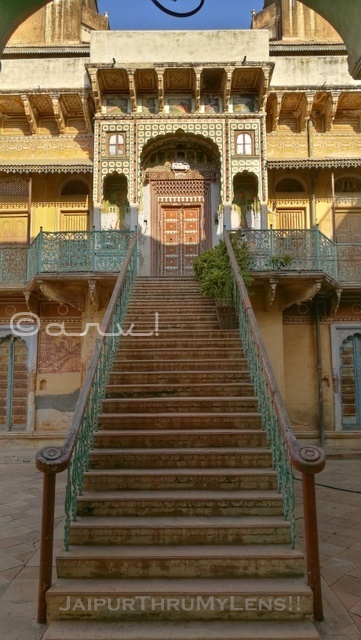
Shekhawati Haveli | The Art on the Wall in The Shekhawati Region
Having explored many other areas in Rajasthan, I decided not to be unfair to this region; I contemplated a trip to Shekhawati. It is impossible to cover the entire belt on a single trip as the number of towns runs in two digits. I decided to traverse this region during multiple road trips. Let me uncover Shekhawati Haveli in this travel blog.
Read another post from Shekhawati – Lohargal Rajasthan
Where is the Shekhawati region?
The Shekhawati falls in three districts – Sikar, Churu, and Jhunjhunu. For centuries, the Rajasthan region was administered by a few major states. These were Jaipur, Shekhawati, Jodhpur, Mewar or Udaipur, Jaisalmer, and Bikaner. A large portion of the Shekhawati region consisting of Jhunjhunu, Fatehpur, and Singhana was governed by Kyamkhani or Qaimkhani Muslim rulers with a power center concentrating around Jhunjhunu in the 1300s-1400s. Qaimkhanis were Muslims converted from Rajputs. Towards the middle and end of 1400, Rao Sheka Ji, a Kacchawa Rajput from the clan of Amer (Jaipur) declared independence from Amer. He established his principality in Amarsar near Shahpura after he had refused to pay tribute to Amer rulers. Rao Shekha belongs to the descendent of Baloji who was the third son of Maharaja Udai Karan of Amer (1366-1388). After the fall of the Mughal empire post-Aurangzeb, the Shekhawat clan started making inroads towards the west and north of Aravali hills which was ruled by Muslim Nawab rulers. The Aravali hills range ends near Udaipurwati, Sikar, and Khandela. The first one to be snatched was Jhunjhunu in 1730 AD, subsequently, it became the capital of the Shekhawati region. Previously, the Shekhawat paid tribute or taxes to the Mughals but Maharajah Sawai Jai Singh II acquired the right to collect tax from the Mughals in the form of Ijara. From then on, the Shekhawat rulers started paying taxes to Jaipur state.
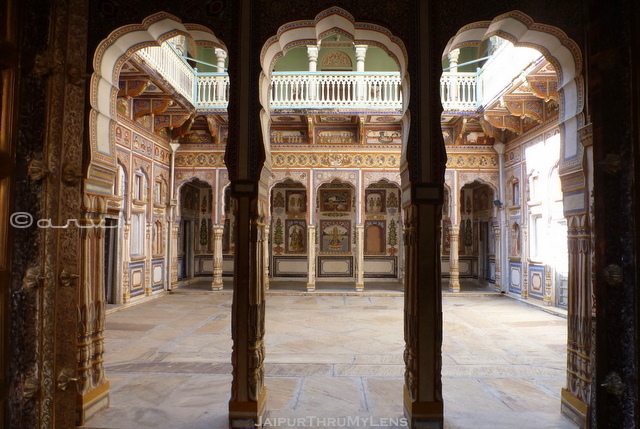
The Shekhawati region was further divided into a sub-principality called Thikana. It was the usual practice in Rajputs of this region to divide the territory or estates among their own clans i.e. sons; it was referred to as Thikana. Hence Shekhawati region was ruled by family members of Shekhawat clans. Some of these important Thikanas were Dhundhlod, Nawalgarh, Mandawa, Khetri, Sikar, and Khandela. This led to a large area like Jhunjhunu into many small segments reducing its importance. These Thikanedars were in alliance with the Jaipur state after the Jaipur state acquired the right to collect tribute from the Shekhawati region. Shekhawat has played a critical role in shaping the history of Jaipur. All these states maintained their presence in Jaipur city by way of mansions like Dundhlod House, and Khandela House, to name a few.
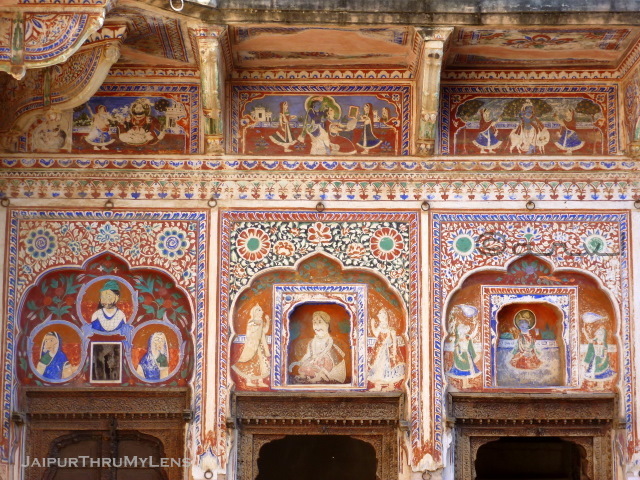
History of Shekhawati Haveli & Region in Rajasthan
Shekhawati Haveli built by the Marwari merchants long before the British colonial rule established major trading ports of Calcutta, Bombay, and Chennai; Shekhawati was an important trade route on the ancient silk route. It connected the trade route between Agra and Delhi with Surat as well as Gujarat. Jaisalmer and Sind were important trading towns too and this region connected with these as well. The camel caravans took goods to the Middle East and China. It facilitated the movement of goods on the Silk Route. The commodities traded were spices, cotton, silk, and opium. One of the reasons for the emergence of Shekhawati as a route for caravans was the low tax rate. In the neighboring states like Bikaner and Jaipur, the tax to be paid by the traders was considerably higher. This was because of political instability in Jaipur which required them to collect a massive amount of funds by way of tax. The Shekhawati rulers played this to their advantage and invited traders to settle in their newly founded towns. The trade flourished from 1822 to 1825 AD. The relationship between traders and rulers was also financial. The former would lend money to the latter to tide over any shortfalls. This relationship was not always amicable. There have been tussles about interest and tax rates between both sides. The Rajput rulers would protect the traders from dacoits in this region. It was only after this region came under the rule of the British that a separate regiment was formed to counter these dacoits. Later this regiment called the Shekhawati regiment also fought in the World War for the Allies.
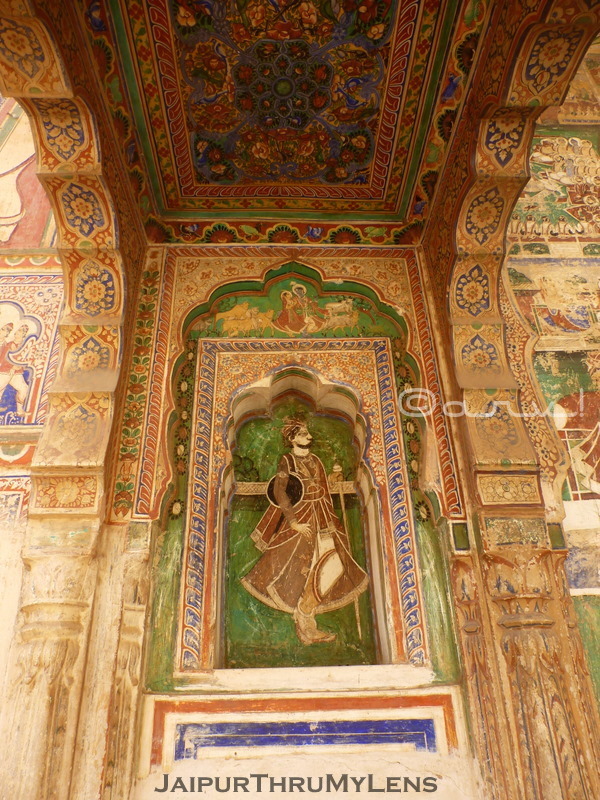
The traders amassed enormous wealth from trade and started investing in decorating the Havelis to flaunt their wealth. Some say the painting of Havelis was inspired by the palace and court of the rulers of this region-Thikanedars. Among the traders of this region were primarily Agarwal and the Maheshwari Bania community. Many of these traders came from other regions of North India like Haryana and Uttar Pradesh as the riches grew in this region. Goenkas, Poddars, Morarka, Birlas, Ruias, and Parasrampuria comprise a few common family names of traders from this region.
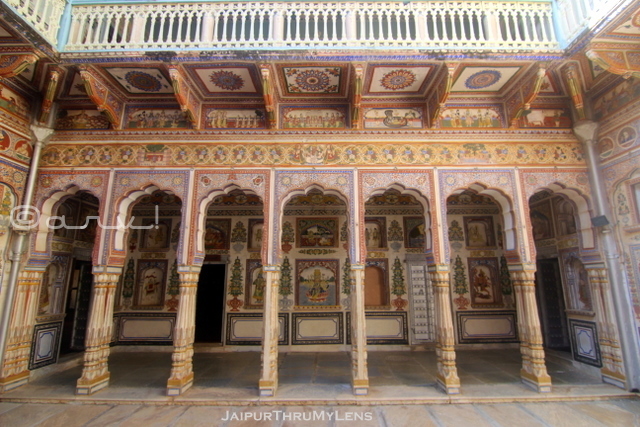
After 1825-30, the ports of Calcutta, Mumbai, and Chennai gained prominence with the rise of British colonial rule. The trade was shifting from the silk route to the British shipping ports. It became evident to the traders that the future in Shekhawati was bleak and money could be made by shifting to these towns. Sizeable traders from this region migrated to Calcutta and other eastern ports. They came to be known as Marwaris.
Who are Marwaris?
Marwari word is a misnomer. The word Marwari indicates a person from Marwar. Marwar refers to the region consisting of Jodhpur, Jaisalmer, and Bikaner. In common parlance, any person belonging to the business community from North India is referred to as Marwari; in practice, this is not accurate. This would be similar to calling any South Indian person Tamil. The word Marwari is derived from the Maroo which means sand referring to the desert of Rajasthan. In Hindi, this would be मरू स्थल or मरू प्रदेश. The business acumen of the Marwari people is well-placed. However, some of the leading business houses in India have their origins in the Shekhawati region like Birlas, Lohias, and Piramal to name a few. The Marwari businessmen were contemporaries of other leading Indian trading communities of those times like Gujratis, Sindhis, Chettiyars, and Parsis. Many business communities like Baghdadi Jews, Armenians, Chinese, Portuguese, and Persians were well-known for their business skills, the world over. They were proactive in carrying on trades beyond their home country. Marwaris on the other hand did not venture beyond the Indian subcontinent. Marwari communities predominantly comprised of Agarwal, Maheshwari’s, and Jains. Some historians believe that Marwari businessmen moved eastwards with the expansion of the Mughals along the Gangetic plains. But it was in greater undivided Bengal where they reaped the benefits most. It was one of the most fertile lands of the subcontinent, and a huge amount of trade took place from Calcutta. They rapidly displaced the Bengali business community with their foresight and astuteness.
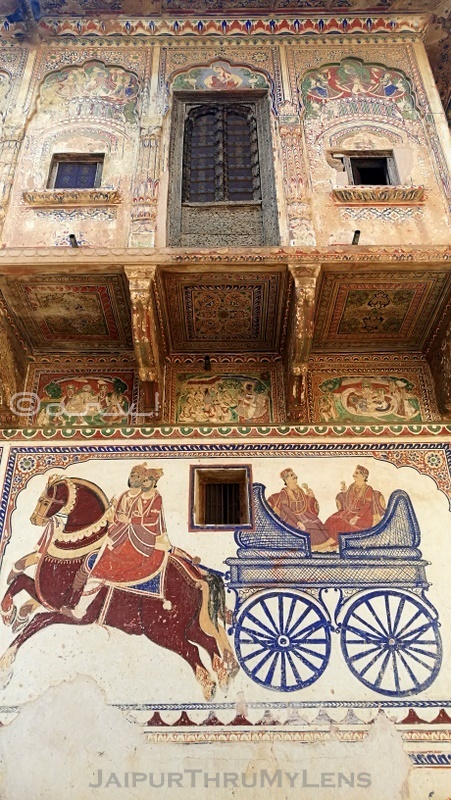
Once the families moved to these new trading ports, they never came back to the towns of Shekhawati. This is a reason why many call these abandoned towns of Shekhawati. In reality, while the traders shifted, many of these towns were bustling small towns as the people from neighboring villages moved here for a better future. Not all are equal though, Nawalgarh, Fatehpur, and Jhunjhunu are the most buzzing whereas places like Dundhlod, Mukundgarh, Bissau, and Khandela retain a small world charm.
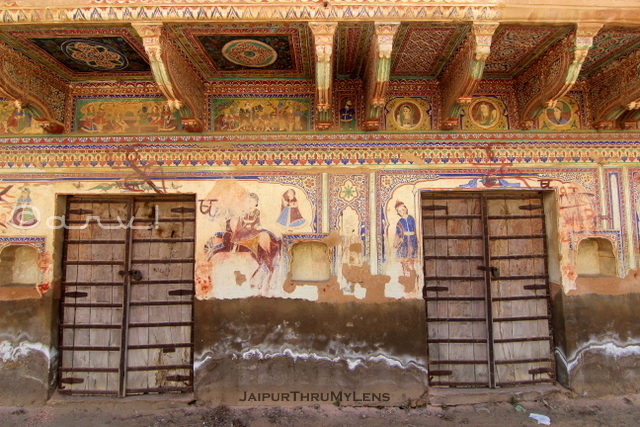
The layout of Shekhawati Towns.
Although not every town is laid out in the same way, there are some similarities. Typically, the center of all the towns is a fort, known in the local language as Garh. The dwelling units are spread all around the fort. In many towns, there is no fort, so the palace or Mahal was the residence of the Thikanedars.
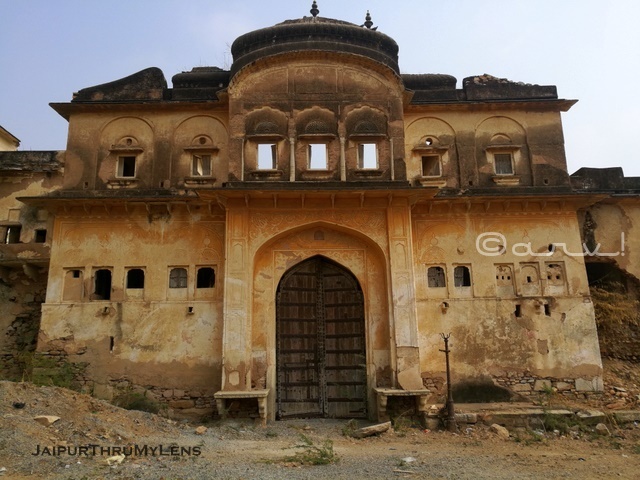
In some towns, the Mahal was part of the fort. One also finds fortified walls surrounding the town along with entry gates.
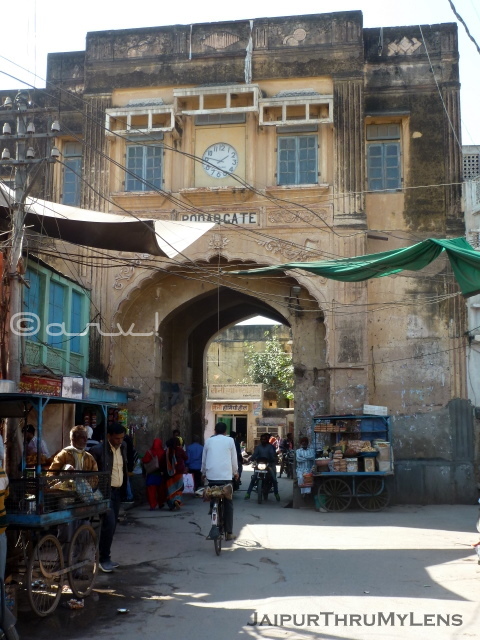
This provided safety and respite from the bandits abound in this region lured by the wealth. People from specific communities were allocated zones called Mohalla a usual feature during those times. The main roads are broader and meant for commercial activities called Bazaar. Usually, the road leading to the fort passed through the market.
Rajasthani Haveli Architecture
The Haveli word originates from Persian implying an enclosed space. Haveli means mansion implying private residence. It follows a familiar architectural pattern. The most distinguishing feature is an inner courtyard called Chowk.
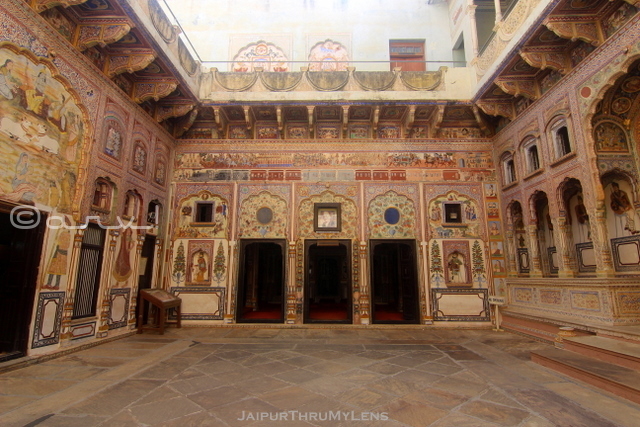
The Havelis facade is dominated by the huge gateway called Pol with two sit-outs on either side. In most Shekhawati Haveli, there are two Chowks.

The first one is reserved for males and guests. The second one is usually bigger than the first and is more private.
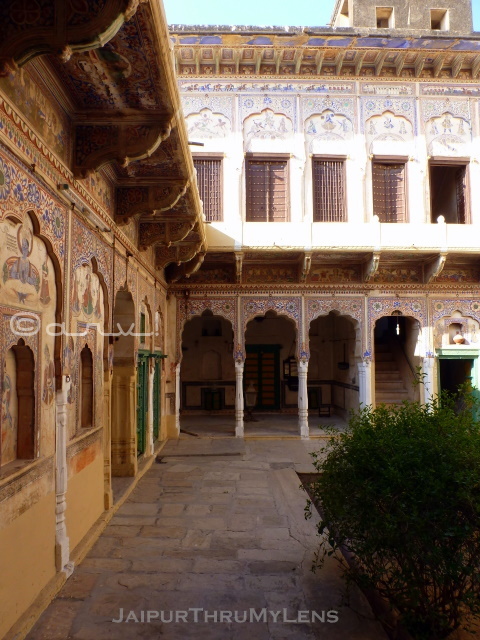
Access to this area was restricted to relatives and close friends. Some term this area of Haveli-Zenana because this area was meant for women.
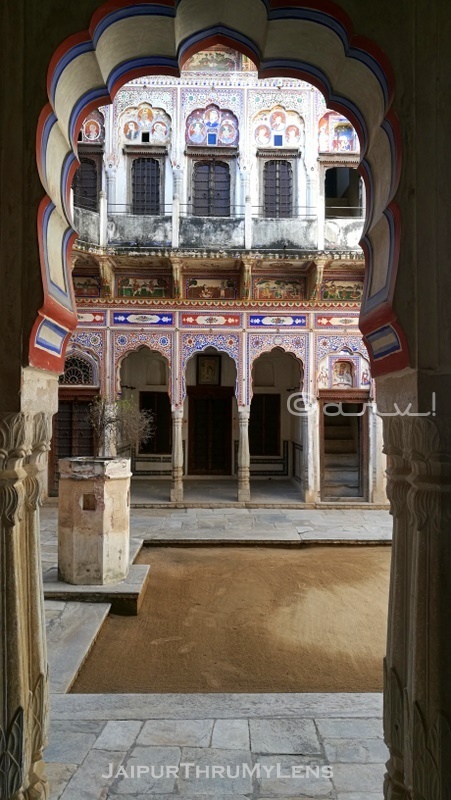
All the rooms open into the courtyard and a Tibari or semi-open sit-out area can be seen right opposite the entrance to this space.
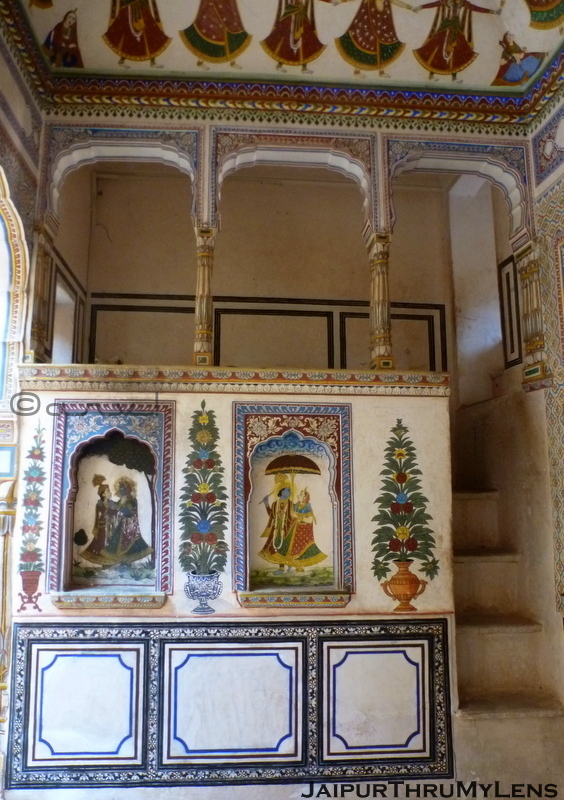
Most Havelis are double story and stairs from the inner courtyard provide access to the second floor. In many rooms, storage was also present called Ducchati.
The architecture and the style of Havelis varied from town to town. Nawalgarh has some of the biggest Havelis in the Shekhawati region. A few Havelis in Laxmangarh and Churu are also quite big. Here are two pictures of Havelis of Fatehpur. Both these Havelis have strong European influence.
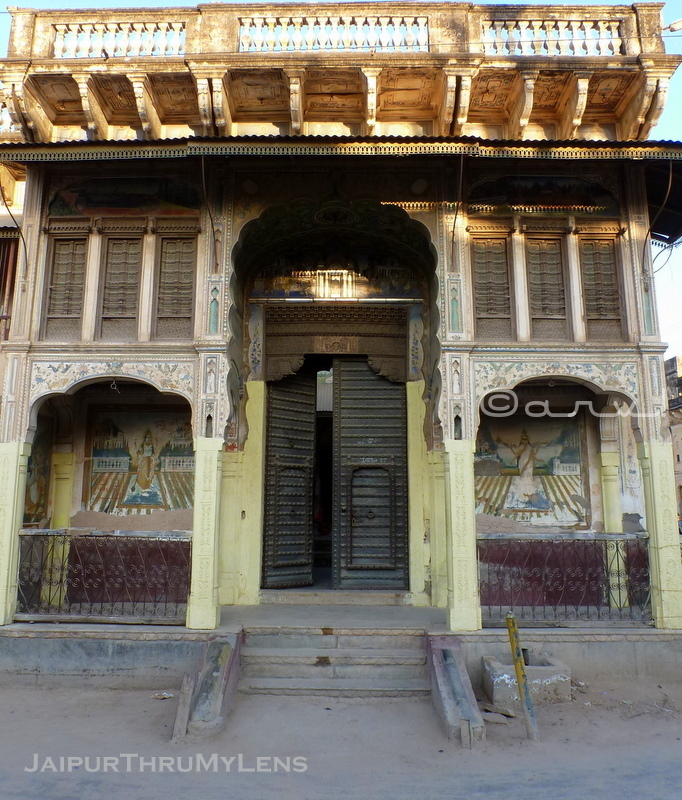
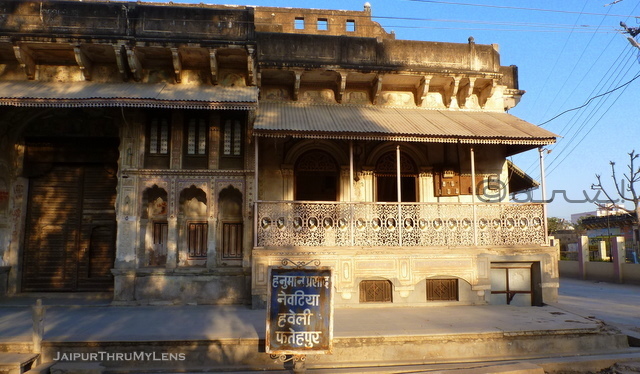
Painted Havelis of Shekhawati
The painted Havelis received impetus from wealthy traders. Some say painted Havelis of Shekhawati were inspired by the palaces and buildings of the Thikanedars or Rajput lords who in turn were motivated by the Jaipur/Amer court. These historians further add that the primary inspiration for painted walls & ceilings came from the Mughal court.

Experts are of the opinion that initially, artisans who painted these Havelis came from Jaipur. As the demand increased, many from the area also came forward to acquire the skills of this art. In many ways, the Havelis built by the merchants were driven by competition from each other.
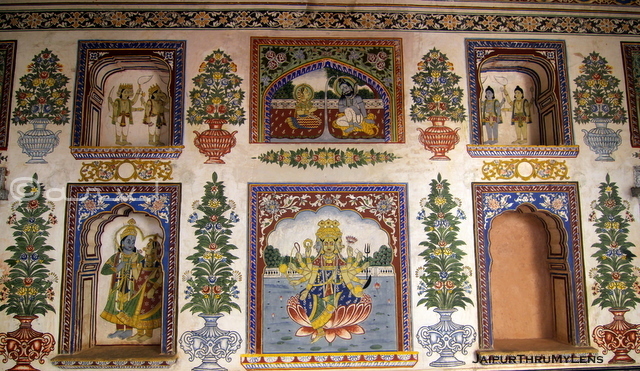
Everyone wanted the build a bigger and more beautiful Haveli. This also spilled into the building of temples, Johara, wells, Dharamshala/Sarai (inns), and Baori/Stepwells in these towns. The wells were built for the use of locals and were named after the family name of traders commissioning them like Poddar Ka Kua(well).
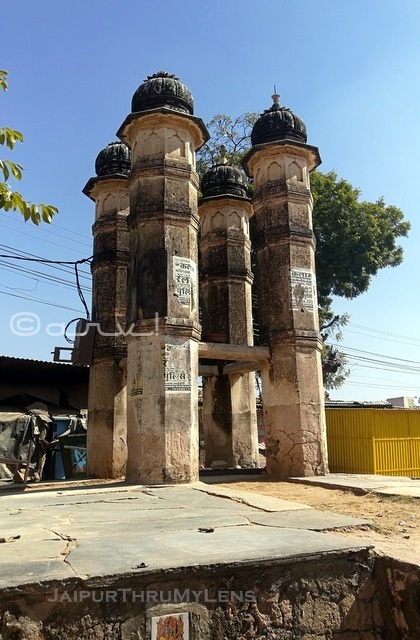
Double Haveli architecture. In many Shekhawati towns, one can find double Haveli. It essentially is two symmetric Havelis in one compound. Chokhani double Haveli in Mandawa is one such example. Here is a picture of double Haveli.
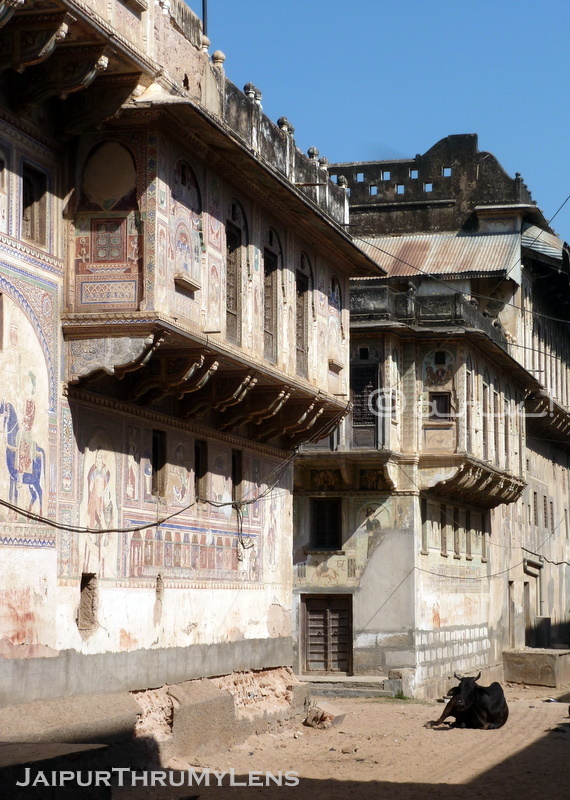
Another variation was four and eight Havelis in one compound. In Nawalgarh, Aath Haveli represents one such example having eight Havelis in a single compound.
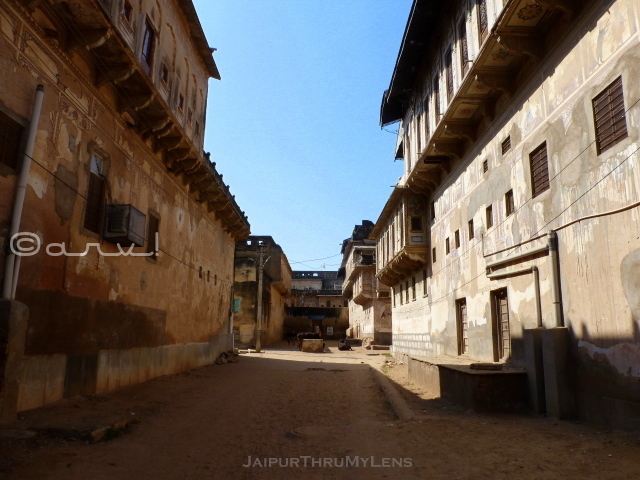
The prevailing themes in the paintings are Krishna, Indian mythological tales, gliders, trains, kings, and queens.
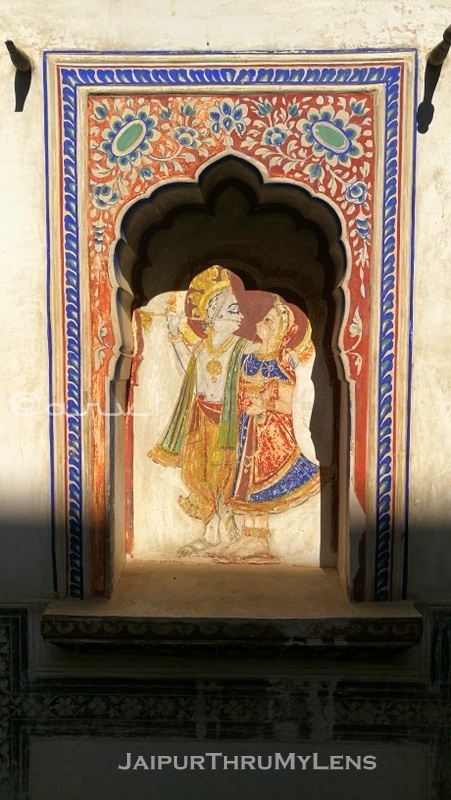
Intricate Doors.
Intricately carved wood doors are the hallmark of the Shekhawati region. It was not merely the door even the door frames were beautifully carved. In most cases, the local wood was used for the door and frames.
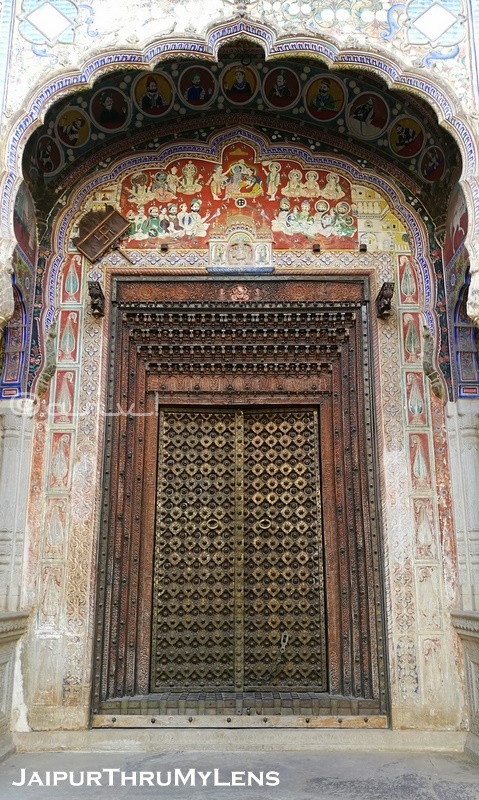
While the outer door, called Pol was huge, the doors leading to the private area of the Haveli were usually small which required a person to bend before entering. The walls around the door frame were adorned with beautiful frescoes. The geometric pattern was the most common design element in the door. In many Havelis, the brass sheet was used on the door. This saved the wood from direct exposure to the vagaries of nature.
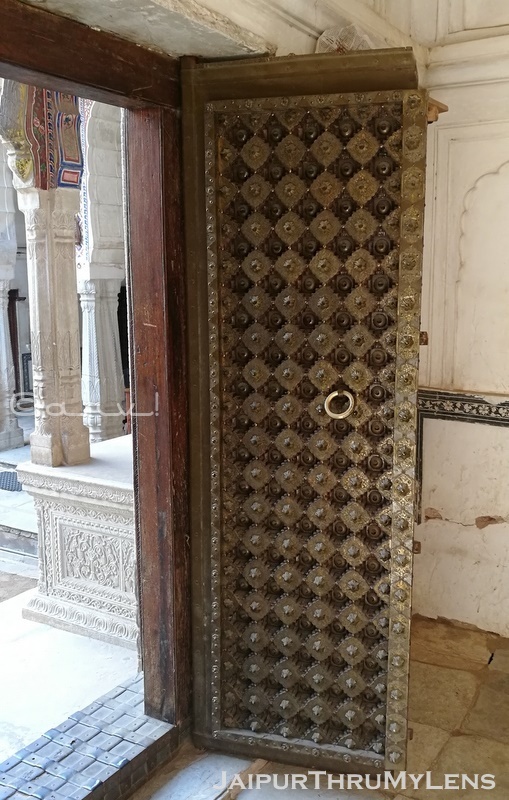
Beautiful Windows
A striking feature of the Shekhawati Haveli was the use of a variety of windows. The windows were not always of identical size. It was dependent on the use. Traditionally, the windows in this region were small. With the European influence, the bigger windows were additionally included in the Havelis.
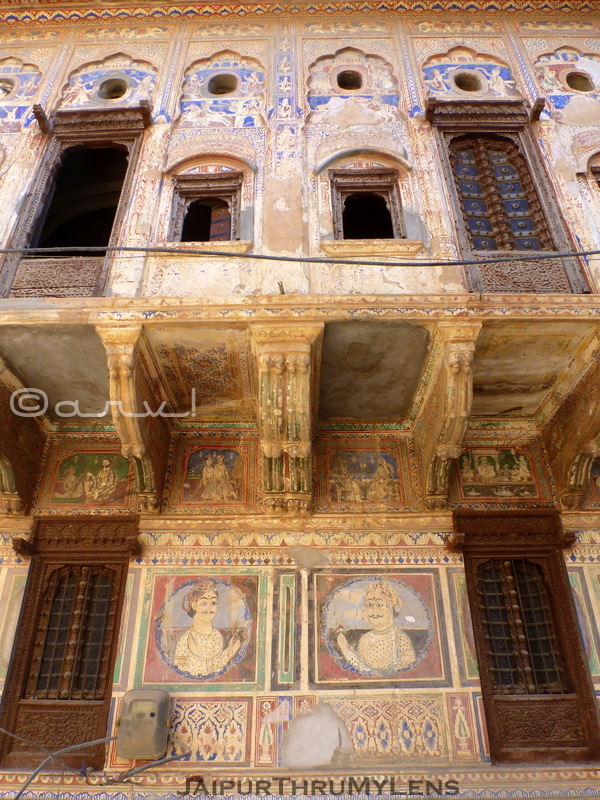
Frescoes in Shekhawati Haveli
The Havelis were painted with frescoes depicting scenes from Lord Krishna’s life, mythology, and contemporary life. Like Amer, some of these paintings from the initial years were made using natural colors and dyes. During later years, with the availability of imported paints and pigments from Europe, it was utilized in the frescoes. In most places, the paintings were done on the entire surface -walls, and ceilings.
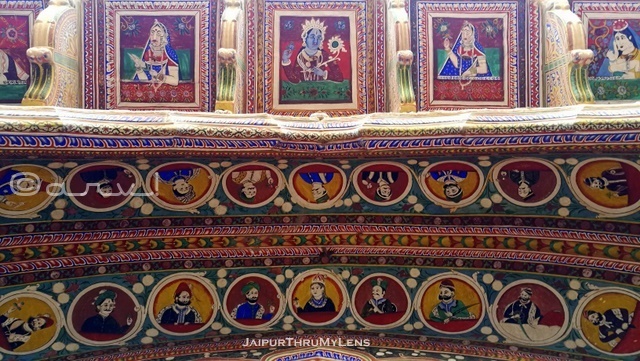
In other cases, it was done on selective surfaces. The fresco subjects and style also vary across the towns of Shekhawati, They are not uniform. Like in some towns, red and blues are overwhelmingly dominant. In some Havelis, other decorative elements have also been used like mirrors and tiles. Mirrors have been a hallmark of Mughal architecture. The Sheesh Mahal in Amer Fort must have been the original inspiration.

The frescoes in these Havelis were painted with two different techniques Buon fresco and Secco fresco style. The former is used when frescoes were painted on wet plaster. Later, the varnish was applied to the murals and left to dry. It is not a problem in this region since humidity is low in this semi-arid region.

This technique allowed longevity as well as the durability of the frescoes. It was extensively applied on exterior walls that were exposed to sunlight, cold, and water.
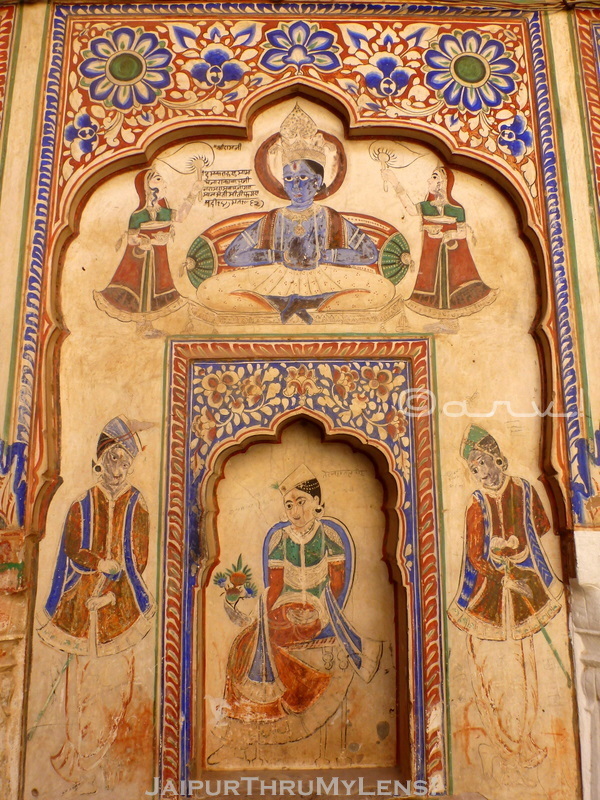
In Secco fresco style, the painting was carried out on dry plaster and used in interior walls since it was unexposed to vagaries of nature like the sun, rain, etc. This technique was more suitable for places that were less prone to damage.

The Future of Shekhawati Haveli?
The overall scenario for the Havelis is bleak with the migration of the owners in search of greener pastures. The chances of them returning to these towns are almost nil due to a lack of viable business opportunities. Many Havelis are locked for 50-100 years. Some are in a ruinous state and on the verge of crumbling. A few sensitive owners have rented out portions of the building, and others have a caretaker to look after the property. Maintaining a huge Haveli remains an expensive affair and not everyone can afford such expenses.
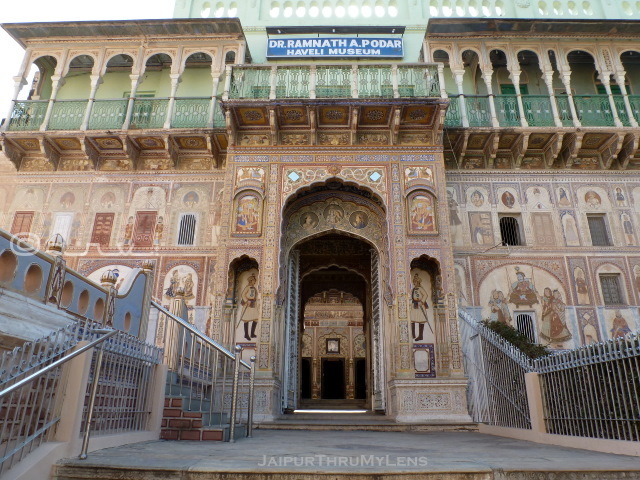
However, there is a silver lining. Some of these Havelis have been converted into museums like Morarka Haveli and Poddar Haveli in Nawalgarh. In other places like Mandawa, while the Havelis haven’t been converted into a museum they generate a paltry sum by way of entry charges.
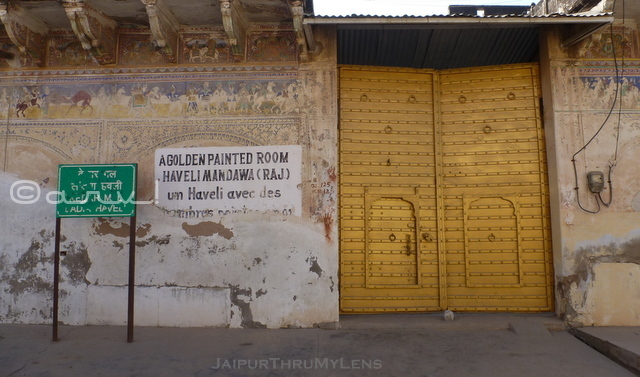
Routinely, Rs 100 is a standard fee. It doesn’t generate a huge revenue but covers the expense of a caretaker.
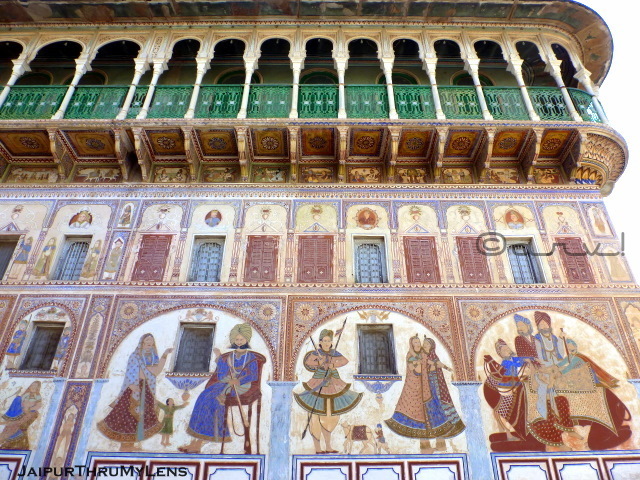
Restoration of Havelis
A short time ago, a Haveli in Nawalgarh was restored by an architect and turned into a museum highlighting the built heritage of the region. The organization responsible for restoration is called the Centre for Advancement of Traditional Building Technique & Skills (CATTS). A brainchild of Ar. Urvashi Srivastava, she is working to raise awareness about the architectural significance of this region and its priceless built heritage through ‘Shekhawati Virasat Abhiyan.’
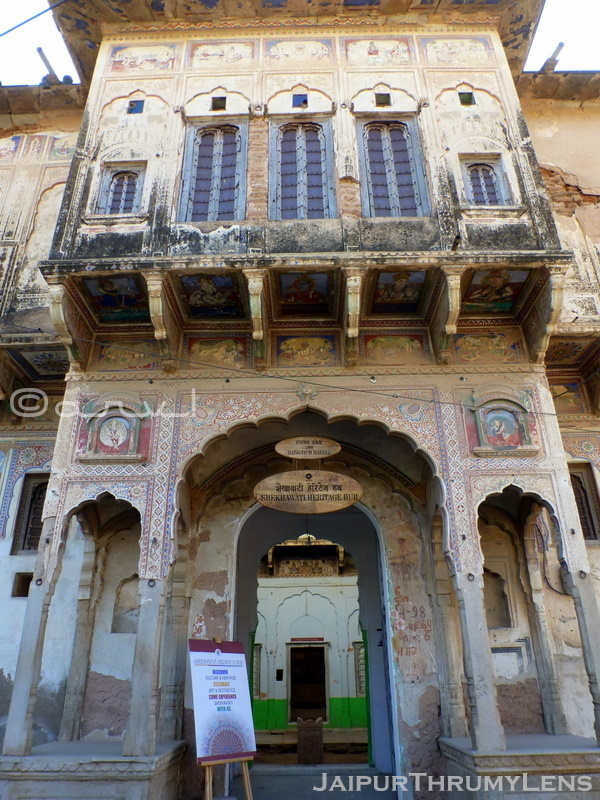
It was coincidently that I found a Havelis restored by her. She had displayed before and after pictures of restored Havelis. She is seeking individuals, institutions, trusts, and organizations that can contribute to her efforts to conserve this precious heritage of the region.
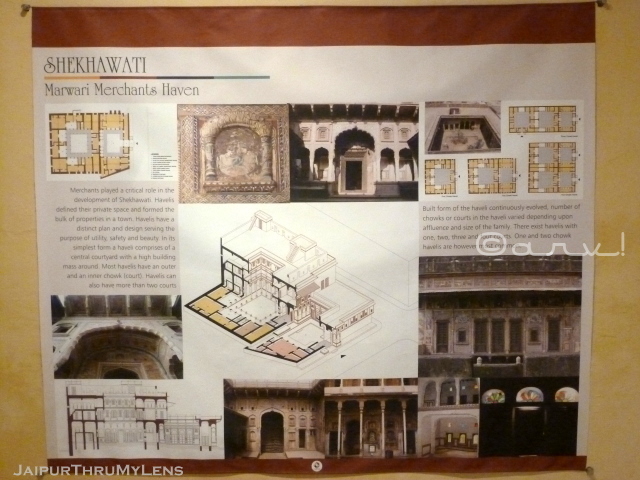
Several Havelis have been converted into heritage hotels in Mandawa, Nawalgarh, Fatehpur, to name a few. A lot many are in the pipeline. It is certainly a good way of generating money and a unique experience for travelers. However, the Havelis have limited capacity in terms of room inventory.
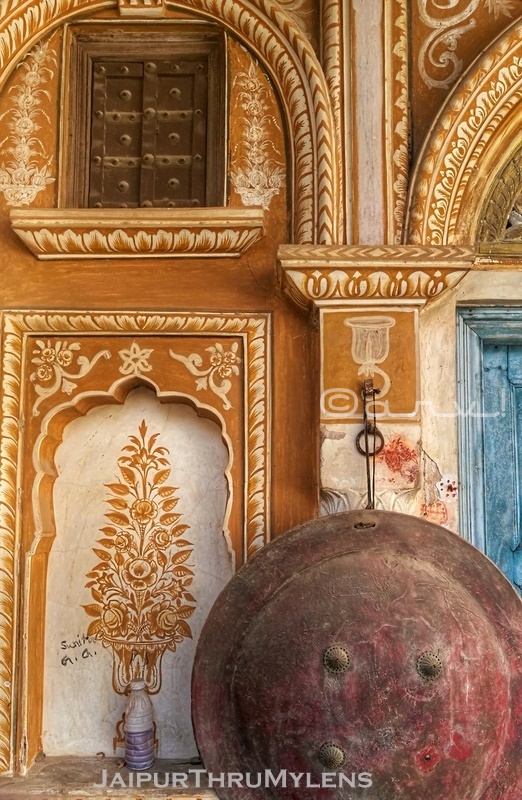
Even now, Shekhawati doesn’t attract tremendous tourists like Jaipur, Jaisalmer, or Udaipur. In many ways, this allows for a more immersive experience for travelers. The tour operators generally plan a day for this region as a stopover in transit from Jaipur to Jaisalmer or Bikaner.
Shekhawati Haveli For Sale
Many Shekhawati Havelis are also available for sale and are being bought by investors. A few hoteliers buy Havelis and turn them into a hotel. The rate for which these Havelis are sold can vary from Rs 50 Lakh to Rs 4 Crore. Many of these Havelis are also being brought but then razed down to build a new residential house. Here is a picture of Haveli in Mandawa that was recently sold and is undergoing restoration. It has been turned into a hotel.
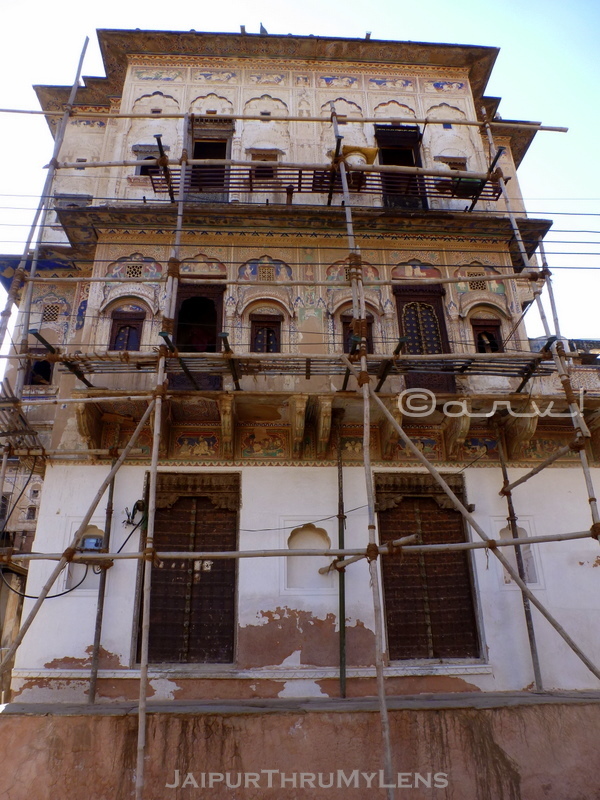
Places to visit in Shekhawati
- Nawalgarh
- Jhunjhunu
- Mandawa
- Ramgarh
- Laxmangarh
- Dundhlod
- Mukundgarh
- Fatehpur
- Churu
- Bissau
- Alsisar
- Mahansar
Shekhawati comprises a vast area and it is difficult to cover the entire region in one go unless you plan to spend 8-10 days minimum. Ideally, it is best to make a single town as a base and cover neighboring towns. Like if you choose Nawalgarh which is one of the most convenient locations in terms of logistics, you can easily cover Mandawa, Dundhlod, Mukundgarh, and Jhunjhunu. Identically, another option is Churu. Mandawa has sizeable stay options. However, I prefer Nawalgarh because of its location advantage.
Where to stay in the Shekhawati Region?
- Nawalgarh
In Nawalgarh, Roop Niwas Kothi, a heritage property run by the erstwhile rulers of Nawalgarh is one of the best options. Its expansive feel is a welcome break from city life. Among many things, they have a horse stable and offer the legendary Marwari horse rides in the region.
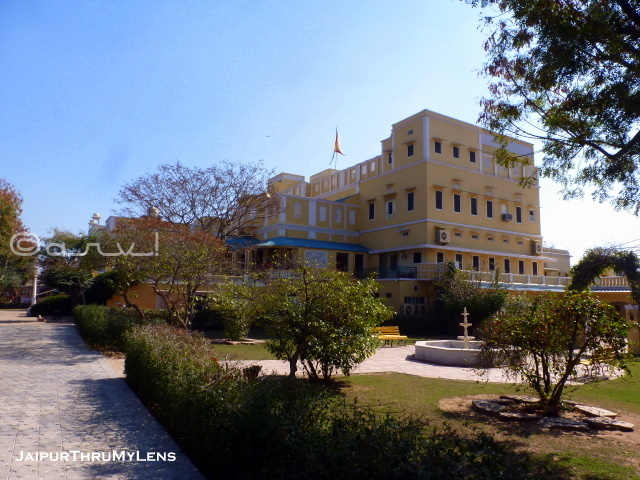
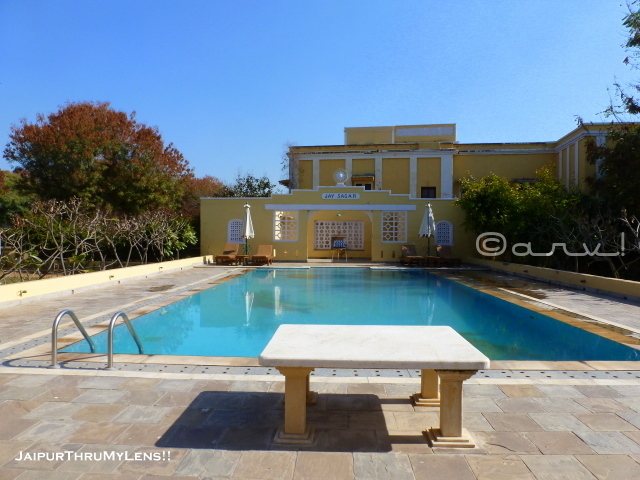
- Mandawa
Mandawa has many Havelis and even Mandawa Fort for stay options. The tourism industry in Mandawa is well developed offering more stay options.
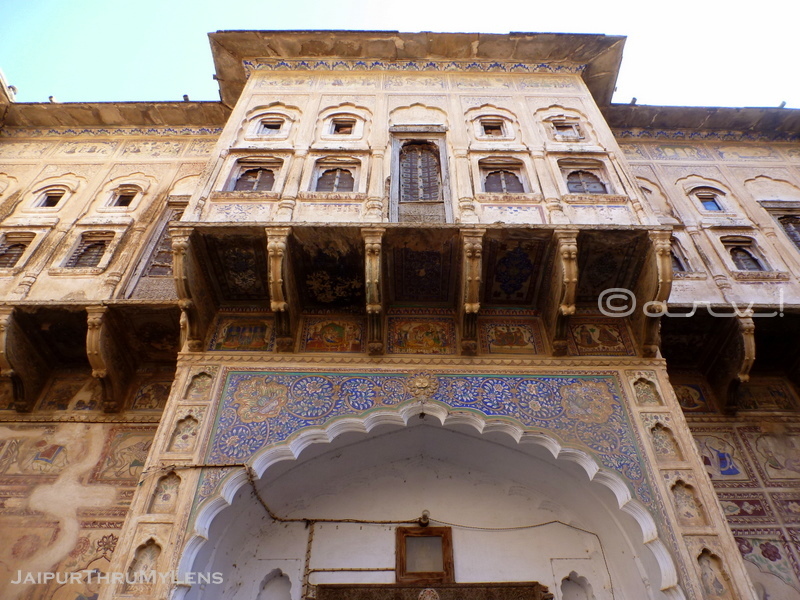
If you wish to visit Fatehpur, Churu, and Nawalgarh, Mandawa remains another good option.
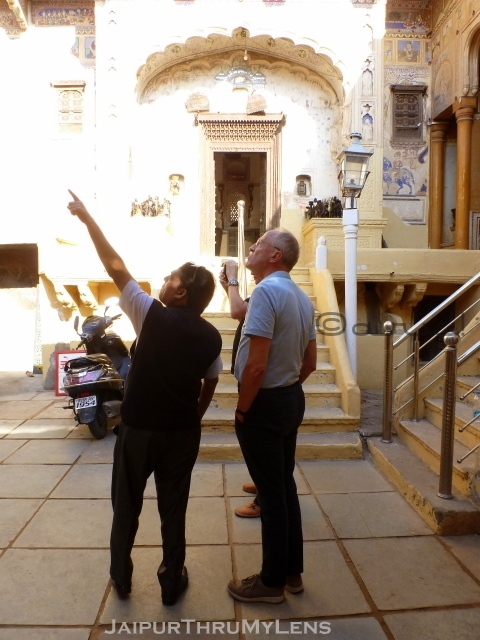
Among the most popular options in Shekhawati, Vivana in Churi Ajitgarh and Maalji Ka Kamra in Churu are the most sought-after.
- Inderpura
Inderpura near Lohargal is a good option if you prefer a rather modern type of stay rather than a Haveli or a fort. Read Inderpura Resort
How to reach
Jaipur To Shekhawati
Jaipur is an ideal place to visit the Shekhawati region in terms of accessibility. It is approximately 100-150 km from Jaipur by road. Only a few towns are connected with the train network, hence the road trip is the best option. To cover multiple towns, it is best to travel by car or taxi. All these towns are covered by the bus network. However, Volvo or similar bus service connections are limited to a few towns. Sikar, Jhunjhunu, and Churu are significant hubs for further connection in this area as far as bus services are concerned. Do note there are many options to choose from when it comes to bus services among private and state buses. Jaipur is well-connected with all major cities in India with trains and flights. Therefore, Jaipur makes for an ideal starting point for Shekhawati.
Delhi To Shekhawati
Train services from Delhi are limited to a few towns. Also, the train frequency is restricted to certain specified days. You can fly to Delhi and then hire a taxi to cover the Shekhawati region. Delhi is well connected with all major cities in India and the world via flights. Delhi is also connected with major towns in Shekhawati by buses. There are many private and state-owned bus services.
Best Time to visit
The best time to visit Shekhawati is in the winter between October to March. Do note the days tend to be shorter between December to February.
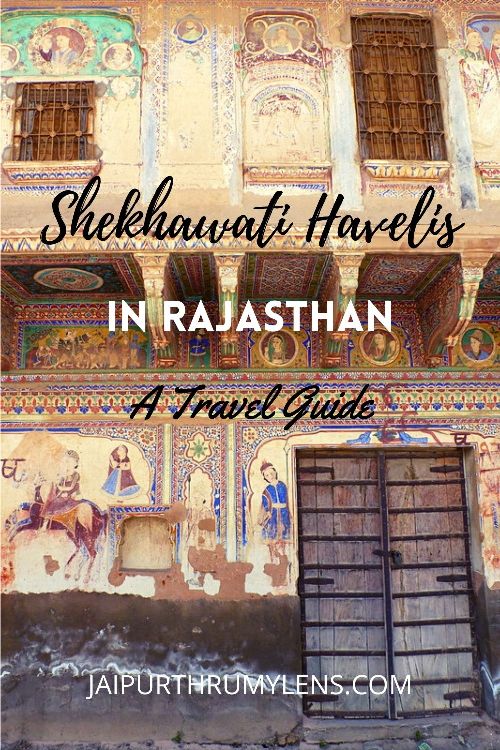
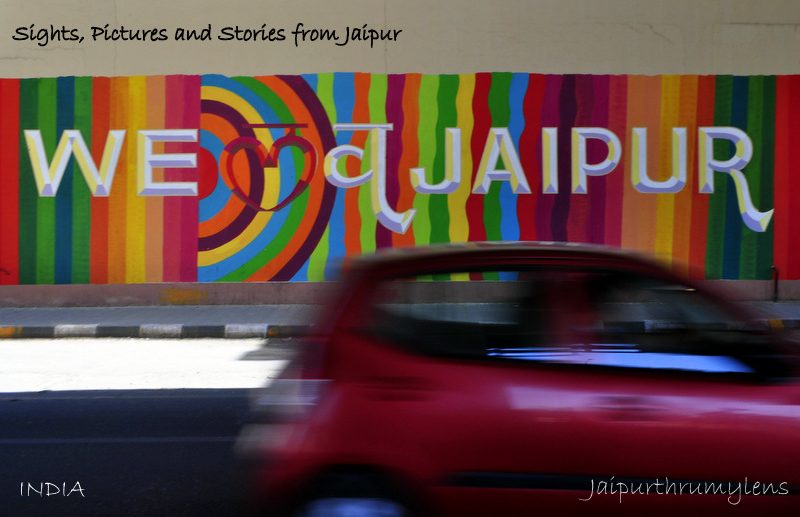
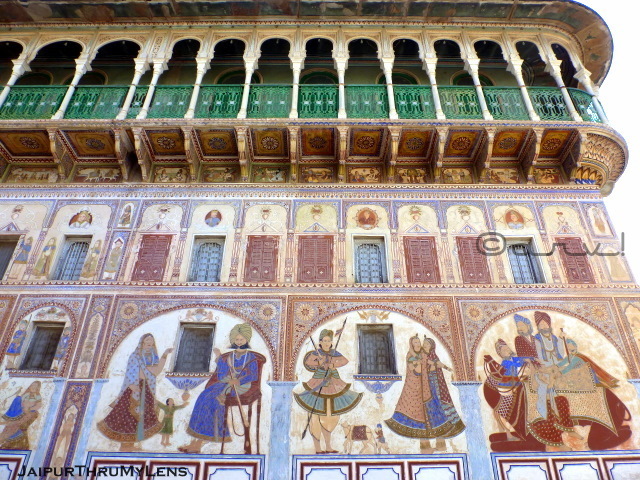
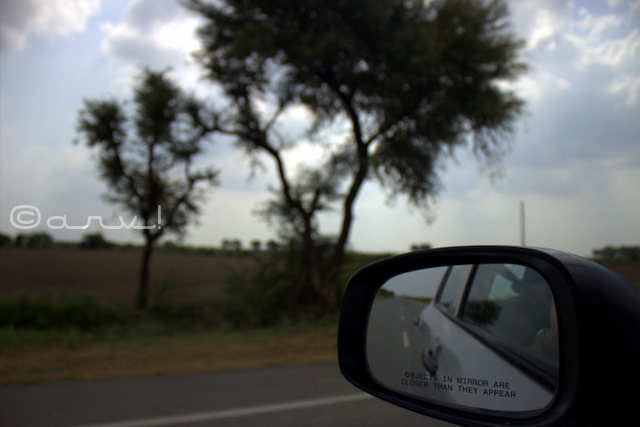
very well written article and beautifully composed… it increased y attention to reach that place.. hope to visit as I’m coming Jaipur on 12th of April!!
LikeLiked by 1 person
Thanks for stopping by and sharing your thoughts, Utkarsh. I hope you will enjoy your trip to Jaipur.
LikeLiked by 1 person
Yes… It’s pandemic but I’m scared.. But than too I’m ready to take the risk…. Today’s my train at 00:15 am 12 th of April
LikeLiked by 1 person
Utkarsh, stay safe. Avoid busy areas. Certainly, not the best times to travel. How many days you are planning to stay in Jaipur?
LikeLiked by 1 person
I’m here only till 15th … But I’m taking all the precautions… Nay God do all the things perfectly… Well whatever hoping for the best.. 🤘
LikeLiked by 1 person
Take care!
LikeLiked by 1 person
Thanks.. And I’m safe… Now at my home back.. ❤
LikeLiked by 1 person
That’s great. Take care, Utkarsh. 😊
LikeLike
LOVED your detailed write up. Having lived in India for2 1/2 decades – I never knew about this place. Is definitely now on my bucket list when I go back to India someday. Great pictures and history 🙂
LikeLiked by 1 person
Sutapa, I’m not sure about the period you have lived in India but this is quite popular these days. This region became prominent only during the last 2 decades. I’m hoping you will be able to visit Shekhawati someday and experience it in person.
LikeLike
This is such a resourceful post. Love that you share they history and details of the regions/towns…as well as a potential guide to form an itinerary for a visit. Thank you! I can’t wait to visit now that I have some background knowledge as a baseline.
LikeLiked by 1 person
I’m glad you enjoyed this post and found it useful. Will await for what you have to say after experiencing it in person. Thanks for sharing your thoughts, Priya.
LikeLike